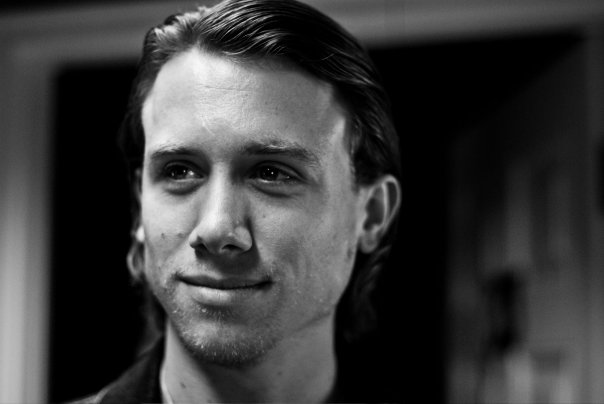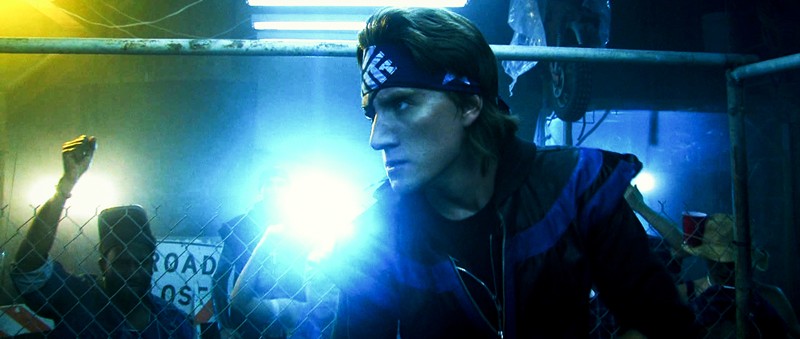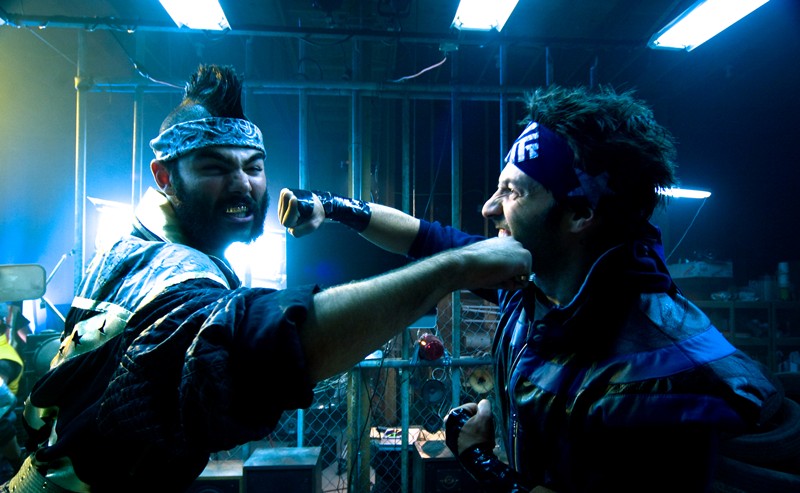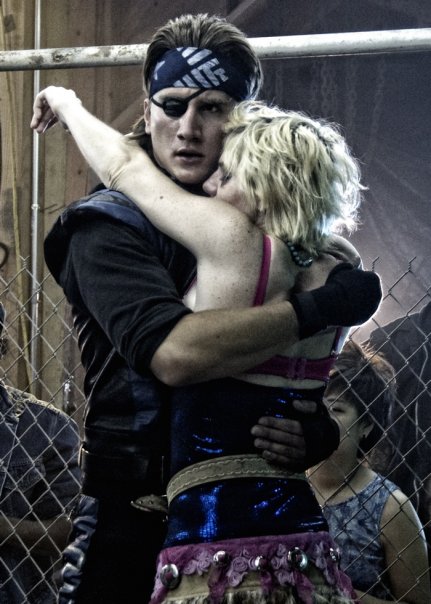 Written and directed by brothers Brandon and Jason Trost, The FP is a movie wherein two rival gangs in the small town of Frazier Park compete against each other in life-or-death matches (literally; you die if you lose) of the arcade dance game “Beat Beat Revelation.”
Written and directed by brothers Brandon and Jason Trost, The FP is a movie wherein two rival gangs in the small town of Frazier Park compete against each other in life-or-death matches (literally; you die if you lose) of the arcade dance game “Beat Beat Revelation.”
Brandon Trost is best known for his work as a cinematographer, having gone behind the camera on Crank 2: High Voltage, Halloween II (the new one) and Macgruber. I interviewed Brandon about Crank 2 for the April 2009 issue of American Cinematographer, and was immediately impressed with his ability to draw a big, energetic look out of the smallest cameras. With The FP — shot on a prosumer camera, with a micro crew and a micro budget in 22 days — once more Trost manages to transcend the limitations of the medium and in the process takes it to a whole new level.
Watching The FP, the entire time I couldn’t help but be reminded of Andrew Laszlo’s work in The Warriors. It’s one of my favorite films, cinematographically speaking, and I loved how you channeled that here.
It’s awesome that you mention Andrew Laszlo in the first place because his work is some of my favorite of all time. The Warriors is great but Streets of Fire is, I think one of the most amazing-looking movies from the 1980’s. Southern Comfort is fantastic too. Even Innerspace. It seems like he used practical lighting in a way that other filmmakers didn’t, particularly in studio movies.
I also really like how you mixed color temperatures of the practical lights in the set, with the orange sodium vapors and blue-green florescents.
We built all the lights into every set. I barely ever used any other light than what you see in the frame. I shoot lights all the time. I’ll literally put a light on a stand in frame in the background, just pointing at the lens. It flares out so you can’t see it, but you can’t really tell if it’s an industrial fixture or what. So they’re either there in the shot creating flares or maybe I’d use a Kino Flo for fill if we had to. We also knew that we had to shoot really fast because we had a limited schedule to shoot this, so every location I wanted to build the lights into it so we wouldn’t have much down time for each setup.
I was so involved in this from the beginning, both writing and directing it with my brother Jason, but also being involved with building the sets with our production designer [Tyler B. Robinson] on the weekends. I would build the lights into the set where I needed them, and I was specifically changing the color temperatures because I knew that we could heighten the saturation later when we did the color correction.
[Colorist] Siggy Ferstl at Company 3 did an awesome job with that as well. I worked with him before on Crank 2 and that’s part of the reason why I wanted to go with him: because of his work with the HDV format. We shot The FP with the same camera we shot Crank 2 with, the Canon XH-A1, and having had experience seeing what we could do with it on the big screen we were totally comfortable with using it to shoot this movie to have it play like a big film and not notice a big lack of resolution.
It’s invisible. If you’re looking for it maybe you can suss it out, how it was shot, but if you’re not trying to look for the zipper in the back of the suit it’s a bulletproof image. How do you handle these cameras in a way to get the most out of the limited technology?
It’s something I’ve been doing since film school, where you take a camera that isn’t necessarily a super pro camera and try to shoot something that looks like film or a higher quality HD camera. I don’t treat the camera any differently, and I don’t just mean that in how you use the camera. I think there’s a certain attitude that you can take to make anything look or feel like a movie. The attitude with which you use the camera is more important than how you light something. It’s all in how you feel when the frame is right, or that’s at least how I do it. When I was shooting DV it was the same way. I just didn’t treat it any differently than I would if I was shooting 35mm.
Because you’re deliberately ignoring the camera’s limitations, your work ends up surpassing them.
If a spot blows out, it blows out. I just embrace it. If it’s too dark in a spot, i’ll just let it fall off, just because. I just tweak it until it looks right, but it doesn’t need to be technically perfect. But then again, I also like mistakes. At least, photographically. I like it when stuff isn’t perfectly balanced, if there’s a hotspot or a part of the frame that’s too dark. I feel like if you go too precise and too glossy it ends up coming between you and the story. You need to allow some mistakes for your work to feel genuine.
When we talked about Crank 2, you told me about all the settings you tweaked in the camera to create imperfections in the image: a narrow shutter, high image detail. Did you do anything similar with The FP?
We did something similar. With Crank 2 we wanted to have as much of an electronic look as possible and the detail helped us with that. It’s very sharp, almost hyper-sharp. I wanted a little bit of that for The FP but I didn’t want to go so crazy with it that it was taking you out of the dramatic moments of the film, and there are a lot of them. Crank 2 is a really fun cinematic experience, but it’s fun based on the fact that we shot it like a skate video. It’s out of its mind, it’s crazy. Lots of wide lenses, lots of handheld. We wanted The FP to feel a little more traditionally cinematic. Traditional in the way our favorite movies are, like The Warriors and Total Recall – all those fantastic classic action films we’re in love with, and we tried to emulate that a little bit, which I also got to do with Macgruber.
But with Macgruber you had a bigger budget, right? Does having more resources to spread around affect your approach?
The crazy thing is that there’s always limitations. Every movie is more ambitious than its budget. You have to just take and make the best of what you have. Even a movie like Macgruber for example, that was a 10-million dollar movie that was supposed to look like an 80-million dollar summer blockbuster, which was part of the joke: We had to emulate that look enough to the point where it could stack up against those films. I also like to set up rules for the look of a film. For Macgruber, I thought, “If we can keep the camera moving, put a couple crane shots in there, it’ll open the movie up to make it feel that much bigger.” Hiding what we don’t have sometimes makes a movie feel like it’s bigger than it is.
Of course, the look still has to serve the story.
You know, I’ve never really been the type of guy who would force anything onto a movie that it doesn’t need just because I think it would look cool. Beat for beat, I make sure everything makes sense and serves the narrative and ultimately give the director what he wants, which I love doing. It’s an awesome challenge and it’s really fun to do and I love collaboratively going through this process. The great thing about The FP is that it was my brother and I in a tiny van with three lights and a bunch of practicals. Together, we made that our look.
Join American Cinematographer on Facebook.
Follow @AmericanCine on Twitter.
[Images via Twitch.]


